Teranex's Star-up converter

The current market for 24p in the United States is larger than most people think. It’s not just George Lucas and a handful of Hollywood studios. There are numerous documentaries and independent production companies using the medium to their advantage.
PostWorks uses the Teranex Star-up converter to upconvert content sources from many formats to 24p to put them all on a level playing field.
PostWorks New York, a post-production facility located in Manhattan, does many projects for theatrical distribution, with film as the end product. The facility handles about one feature-length film per month, and many documentaries. Examples include “A Decade Under the Influence,” about the best films of the 1970s, and “The Billabong Odyssey,” about a quest to surf the world’s largest waves. These and other documentaries often use multiple sources on different film and video formats (interviews shot on 24p and archival footage on every format imaginable). The facility also handles narrative films.
But no matter what formats its clients use, PostWorks encourages them to start working in a 24p environment as soon as possible so that they have the best idea of what the final product is going to look like.
One of the biggest misconceptions in the post-production industry is that all HD programs are created only from HD sources. The fact is that, more often than not, PostWorks has been faced with the challenge of mixing HD with standard-definition material. To give the final film a consistent look, the facility had been using software-based products. But the rendering times required by these products were excessive. The solution was to use the Teranex Star-up converter to put all the sources on a level playing field.
For “A Decade Under the Influence,” all of the interviews were shot on 24p HD, but all the films and archival material were from any number of sources, including DVD. The facility originally had no intention of actually using the DVD as a source in the final film, but the Teranex converter made it possible. Other film transfers came in on various formats, including Digital Betacam, Betacam SP and D1.
For “The Billabong Odyssey,” which was shot primarily on 35mm film and HD video, the converter expanded the usable footage to include such formats as Digital Betacam and Beta SP. For both projects, the converter was used to get everything over to 24p/HD. One of the features that most impressed the facility was its ability to auto-detect cadence to remove the additional frames introduced in the telecine process, leaving the original 24 frames.
PostWorks chose the converter for several reasons, including its well-thought-out design. The converter also offered the ability to adjust the colorspace or noise reduction filters. The company also took into consideration the re-shaping of time code and working with the audio delay inherent to image processing. Another factor was that the converter had DLP colorspace look-up tables built into it. Its modular hardware and software allows it to be enhanced or upgraded at any time. As digital projectors change, the Teranex can change with them. PostWorks anticipates further developments with the converter, such as dust removal and the DLP codec. The facility also felt that Teranex was very responsive to its needs.
Billy Baldwin is the founder and CEO of PostWorks New York.
Get the TV Tech Newsletter
The professional video industry's #1 source for news, trends and product and tech information. Sign up below.
